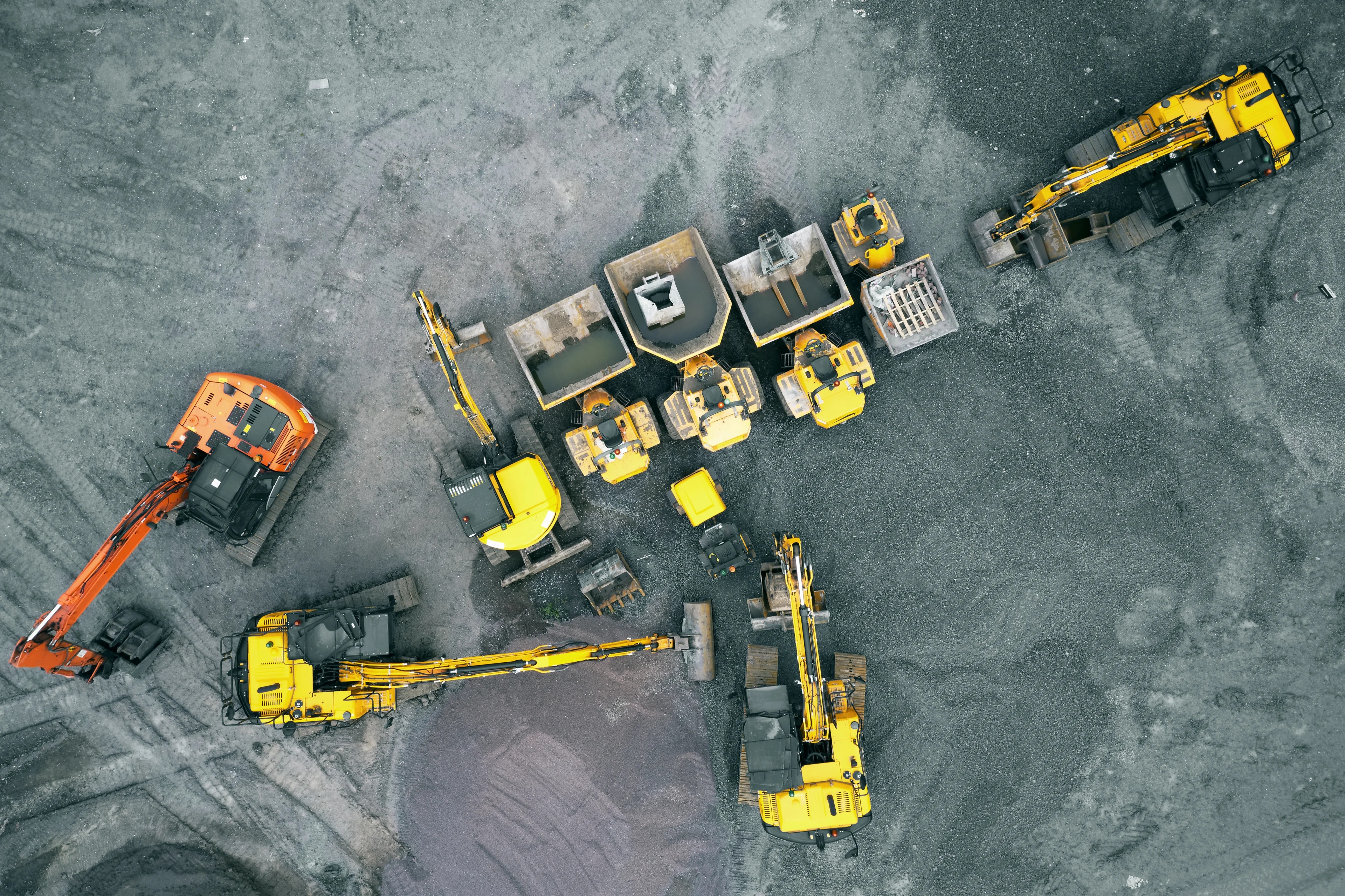
Transportation
6 minute read
Heavy-duty transport requires heavy-duty decarbonization using renewable fuels
Excavators. Harvesters. Long-haul trucks. Material-handling machines. These are just a few of the vehicles that help provide access to basic needs such as food, water, and shelter for people around the globe, and in doing so, prop up the global economy. Demand for such vehicles continues to rise year after year – and with it, demand for the diesel fuel that powers the vast majority of their engines. It’s no secret that we rely heavily on these diesel-powered vehicles and machines. They plow fields, distribute goods, remove refuse, and help build homes. Because of the emissions they create, however, they also pose a serious challenge to the sustainability goals of businesses, nations, and the world at large.
Looking forward in the direction of net zero, two things are clear.
For the foreseeable future, internal combustion engines (ICEs) will continue to play a variety of important roles in industries worldwide.
The only way to meet our climate targets will be to reduce the life-cycle emissions associated with those engines by powering them with renewable fuels.
Factors driving demand
By 2040, the global population is expected to increase by 1.4 billion1 and an additional 1.6 billion people will live in cities2. As a result, primary energy demand will increase by 20%3 and waste generation by 40%4. In this time, the middle class will have grown by more than 30%5.
These megatrends will necessitate an increase in the activity of many industries – including agriculture, construction, mining, freight, and waste management – that rely on heavy-duty vehicles. The heavy-duty category includes all vehicles that have a gross vehicle weight rating (GVWR) of more than 11,793 kg (26,000 lb), and includes transit buses, waste removal trucks, mobile cranes, cement mixers, and many more.
Why renewable fuels?
Some transportation modes are being revolutionized by technologies like electrification and renewable energy. Others, however, are currently unable to make use of those solutions at scale. This is particularly true in the heavy-duty sector due to a range of factors that include a lack of infrastructure, production scalability, and the problem of energy density.
Electrification continues to be explored in heavy-duty applications, but most heavy-duty vehicles will run on liquid fuel for many years to come. Following a decade of strong growth, more than 10 million vehicles run on electricity today – but even if that number were to increase to over 600 million by 2040, the majority of vehicles on the road (as many as two billion, according to the World Economic Forum) would still require liquid fuel, as would many planes, ships, and other heavy-duty machines.
Not all liquid fuels are equal, however, and there is a crucial opportunity for fuels produced from renewable raw materials to displace the demand for fossil-based fuels. The global transport sector’s liquid fuel demand is projected at 2,800 Mtoe (million tons of oil equivalent) by 2040, but renewable raw materials could replace more than 1,000 Mtoe of crude oil use. That number could grow as additional raw material pools are better understood and utilized.
The importance of increasing the use of renewable fuel can hardly be overstated. Renewable diesel made from 100% renewable raw materials results in emissions reductions by as much as 75-95%* when compared to fossil diesel. This means that a diesel-powered vehicle that runs on waste- and residue-based renewable fuel provides a similar CO2 savings over its life cycle as an electric vehicle of the same type, running on 100% renewable electricity.
OEMs including Volvo and Scania are turning to renewable fuel out of necessity; both companies have committed to the Science Based Targets initiative (SBTi), and meeting those targets requires requires the utilization of solutions that are available immediately. Similarly, all medium- and heavy-duty truck manufacturers in Europe have committed to only selling trucks that run on fossil-free fuels by 2040, laying the foundation for a large increase in demand for renewable diesel on the continent.
“Renewable fuels are an important part of Scania’s decarbonisation roadmap. Scania has the largest portfolio of engines on the market that can run on alternatives to fossil fuel. All Scania diesel vehicles can be fueled with HVO100, without any modifications or limitations” says Stefano Fedel, Executive Vice President, Head of Sales and Marketing.
Unlike scalable electrification, hydrogen, and other potential solutions of the future, renewable diesel is capable of revolutionizing heavy-duty transport today – and does not require infrastructure changes or engine modifications. Businesses and other large fuel consumers who switch to renewable diesel can protect their fleet investments while simultaneously reducing emissions and taking positive action on climate and sustainability goals.
Powering change through partnerships
Neste is the world’s largest producer of renewable diesel, and is committed to helping its customers reduce greenhouse gas (GHG) emissions by at least 20 million tons annually by 2030. To accomplish this goal, the company pursues ambitious collaborations with OEMs (original equipment manufacturers) to provide better access to emissions reductions technology across the board. In addition to the distribution and use of renewable diesel, examples of joint projects between Neste and OEMs include:
the development of technical solutions to prove vehicles are running on renewable fuel
the transfer of sustainability data to end customers
the integration of filling stations that offer renewable fuel into fleet GPS systems.
Liebherr, a global leader in crane manufacturing, is one of the OEMs that has chosen to partner with Neste. Starting in 2021, the company began using Neste MY Renewable Diesel™ to power mobile and crawler cranes at its Ehingen plant, and in 2022, expanded the use of the fuel to its Kirchdorf plant, where approximately 2,500 machines are manufactured annually.
“We will be able to save 2.5 million liters of fossil diesel per year by switching to Neste MY Renewable Diesel. That will mean an annual reduction of around 6,500 tons of CO2,” said Ulrich Heusel, Production Director at Liebherr-Werk Ehingen GmbH.
In 2016, Volvo Trucks North America and Mack Trucks, Inc. (both part of the Volvo Group) became the first two OEMs to commit to using renewable diesel in their heavy-haulage trucks. Both companies carried out independent testing of Neste’s proprietary renewable diesel and consequently endorsed its use in all of their engines. Since then, Volvo has continued to work with Neste to find solutions for its wide range of manufactured equipment, including Volvo Trucks, Volvo Bus, Volvo Penta, and Volvo Powertrain.
Frank Bio, former Director of Sales Development, Specialty Vehicle & Alternative Fuels, explained the importance of environmental care from Volvo’s perspective: “Engineers design to it, production builds with it, and purchasing selects suppliers with it.”
Liebherr and the Volvo Group are far from the only OEMs embracing renewable diesel. While electrification and other solutions will undoubtedly be vital in the long term, renewable fuel can change the outlook on sustainability right away, and companies are taking note. As investments spur more development, governments pursue decarbonization, and urgency around climate change increases, it is certain that renewable fuels will play a large role in moving the transportation sector toward circularity.
To reach the climate targets, cooperation is really key. It is clear that all solutions will be needed to replace fossil fuel", says Mats Hultman Head of OEM Partnerships at Neste.
Sources: 1&2: UN, 3: IEA Stated Policies Scenario, 4: World Bank, 5:The Brookings Institution
*The GHG emission reduction varies depending on the region-specific legislation that provides the methodology for the calculations (e.g. EU RED II 2018/2001/EU for Europe and US California LCFS for the US), and the raw material mix used to manufacture the product for each market.
Credits:
Neste




